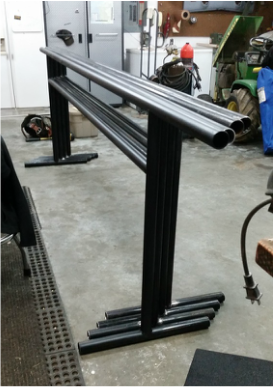|
One of the most important pieces of equipment in a ballet school is the barre. As we were planning Opus Performing Arts, we thoroughly researched all available options for ballet barres. In the end, we decided to make our own barres for the following reasons:
- Commercially available barres are expensive. Typically, a professional grade 12’ barre costs between $400-$1000 for a free-standing model, and between $300-$600 for a wall mounted version. - Our experience with commercially available free standing barres is that even the highest quality models eventually have failures at the connection points. - We wanted barres that were absolutely rock solid and would last “forever”. We believe that most commercial free-standing barres are too lightweight and “flimsy”. - We wanted a barre system that was flexible enough to meet the needs of our school’s schedule of ballet classes for many age ranges as well as modern, jazz, and tap classes. In order to give Opus the maximum flexibility in our class schedule, we decided to build two free standing 12 foot barres for each of our two dance studios. We chose free standing barres so we could (1) have dancers on both sides and (2) orient the barres as either one long 24’ length ot two parallel 12’ lengths. Since (unlike commercial barres) we have no need to dismantle the barres for shipping, we decided to eliminate joints (and hence the possibility of joint failures) by using steel tubes and welding the joints. The exact specifications of the barres are as follows: - Tubing material is schedule 40 1 ½ inch steel black pipe. This pipe has an outside diameter of 1.9”. The use of 1.9” diameter tubing (a) makes welds much stronger and (b) is very comfortable to grip - The top of the barre is 12’ long and is 42” above the floor - The legs of the barre are an inverted “T” with the “feet” (i.e. the part of the leg that lays flat on the foor) being 2’ long. - The top of the barre overhangs the legs by 18” on either side. This allows for easy moving of the barre. - We decided to have a lower barre welded between the legs at a height of 32” for our younger dancers Schedule 40 pipe is available at most steel suppliers (search “steel pipe cityname”). The pipe comes in 21’ lengths, and the steel vendor will usually make one cut per pipe at no additional cost. I had the pipes cut into 12’ and 9’ lengths to minimize waste. Our welder had no trouble fabricating the barres. Included in the fabricating was thorough de-burring of all the exposed ends. The result is a smooth, rounded edge that does not require any type of end cap. After our welder completed the barres I purchased rubber feet (1.5” diameter and 1” thick) on-line and bolted them to the ends of the “feet” of the barre. This has worked extremely well in eliminating damage to the marley in our studios. To finish the barres, I first sanded the surfaces with 180 grit sandpaper to smooth out the horizontal gripping surfaces and prep for painting. I then sprayed with Rustoleum textured black paint. Three coats resulted in a beautiful finish that resembles powder coating at a fraction of the price. Dancer response to the barres has been uniformly excellent. Though heavy (they weight about 60 lbs each) two young dancers have no trouble moving them into the center and back up against the walls when needed. We have had no issues with the fixed heights of the barres. Total cost for 4 barres was about $450 in materials and $400 for welding services, for a total cost of $850, or $212 per barre.
2 Comments
Leave a Reply. |
AuthorI'm Allan Redstone, one of the co-owners of Opus. I'll use this blog to post news items about Opus, as well as dance and music related items that may be of interest to our school community Archives
August 2016
Categories |
|
Opus Performing Arts
207 Prospect Street Suite 201, Bellingham WA 98225 360-734-5300 [email protected] |
|
|


 RSS Feed
RSS Feed

